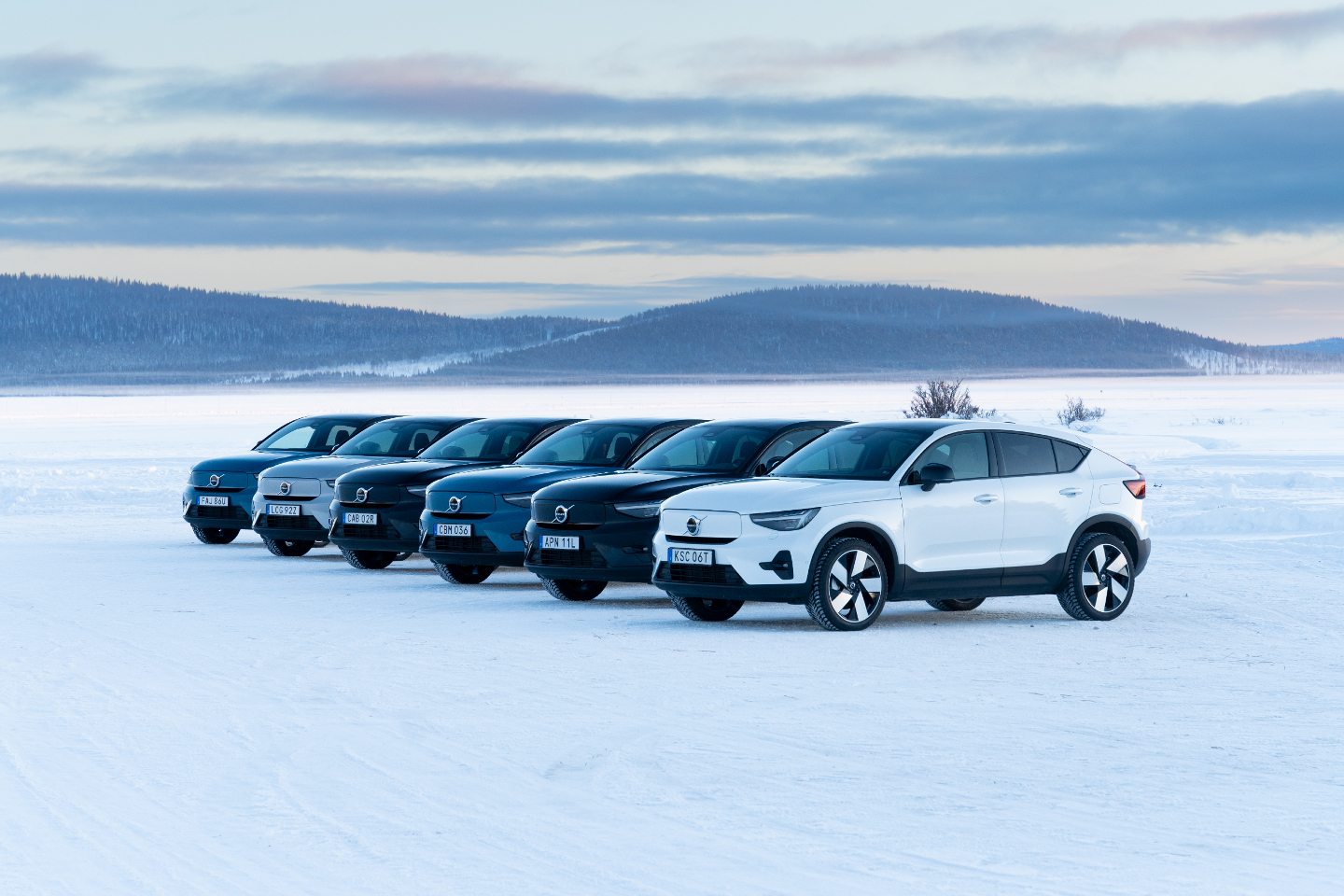
The C40 models neatly lined up on the ice track (Photo: Matt Robinson)
Safety, safety, safety. For decades, that has been Volvo Cars’ mantra. There is virtually no other carmaker that has taken the safety of its passengers quite as seriously. The company was responsible for developing the modern three-point seat belt, an invention that has rescued countless lives since 1959 and is considered one of the world’s most important traffic safety innovations ever.
In its pursuit, the brand has made some eyebrow-raising decisions, namely the 180kph speed limit cap imposed on all its vehicles from 2020, which is in line with its vision that no one be killed or seriously injured in a Volvo. But lately, its ethos has evolved to involve another key driver: sustainability. The plan is ambitious. Volvo aims to electrify its range and have 50% of its sales volume fully electric by 2025.
The Recharge range is the overarching name for all Volvos equipped with a fully electric or plug-in hybrid powertrain. It debuted with the XC40 Recharge in 2021, a palimpsest of its best-selling XC40 compact premium SUV. The following year saw the unveiling of the C40 Recharge, a sleek crossover with a noticeably new look.
In many ways, the C40 is a true embodiment of Volvo’s plan for the future. It is the first Volvo model in the brand’s history designed as a pure electric-only vehicle and represents a fitting herald that signals the arrival of an era of emission-free driving. While both models are already available in Malaysia, we had the pleasure of taking the C40 for a spin in its Swedish homeland, starting from its city of provenance, Gothenburg.
The C40 is a little smaller than the XC40 Recharge, but what it lacks in size, it makes up for in good looks. The C40 started as a spontaneous sketch by one of the team’s designers that materialised as the dynamic and trim vehicle we see today. While it gives the same sense of power and strength as its older sibling, there is added purity, lightness and sophistication courtesy of the scooped-out design on the lower rocker and coupé line silhouette, enhanced by the LED lights in the rear that extend vertically. It is a tough little character with a refreshing personality.
dippedinbluec40testdrive_mattrobinson290122-12.jpg
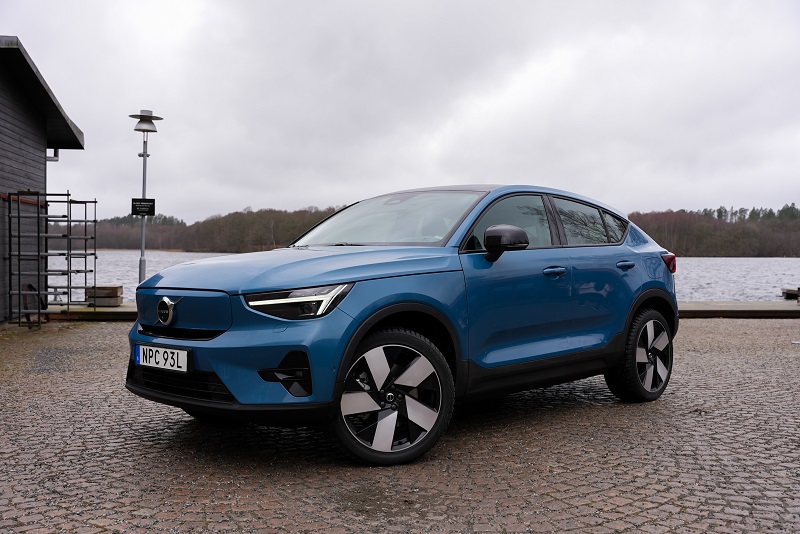
In Scandinavian style
The game plan was to travel from the city to the suburbs and back, and the road trip promised a nice mix of urban and rural routes and views. Google users will have no issues engaging with the infotainment system, which is fully integrated with in-car apps, including Google Assistant, Calendar and Contacts. Although the interface felt a tad rudimentary, it was at least uncomplicated. After keying in our destination, we began our circuitous journey and the navigation experience — Google Maps is reliable anyway — was nothing but smooth.
Because we were travelling on icy roads, studded winter tyres were swapped in for better traction. It produced a little more noise than one would expect but it was never audibly intrusive. The model comes with single and twin electric motors, but only the all-wheel-drive variant is currently available in Malaysia. The latter is powered by a 78kWh lithium-ion battery that delivers 408 horsepower and 660Nm of torque. That is enough to complete the century sprint in 4.5 seconds. How is that for a sleeper build?
With a respectable 450km range, running out of juice was never a concern for our trip. However, one-pedal driving can take a little getting used to. It can be switched off, of course, but having it on regenerates the battery, especially when crawling through traffic or descending downhill. And if you must know, the battery can be replenished from 10% to 80% in just over 30 minutes with a fast charger, but it will take around eight hours with a standard AC home wallbox.
We exited the motorways and skirted around inlets fringed by marcescent trees before arriving at Nääs Fabriker, a hotel-cum-restaurant overlooking Lake Sävelången for a coffee break, or fika, as the Swedes call it. Given that the weather was borderline dour, any sliver of sunshine that successfully penetrated the clouds offered a stroke of vibrancy wherever it fell. When the gentle beams spotlighted the car, it was enlivened with a subtle glisten.
c40-bev-gallery-5-16x9.jpg
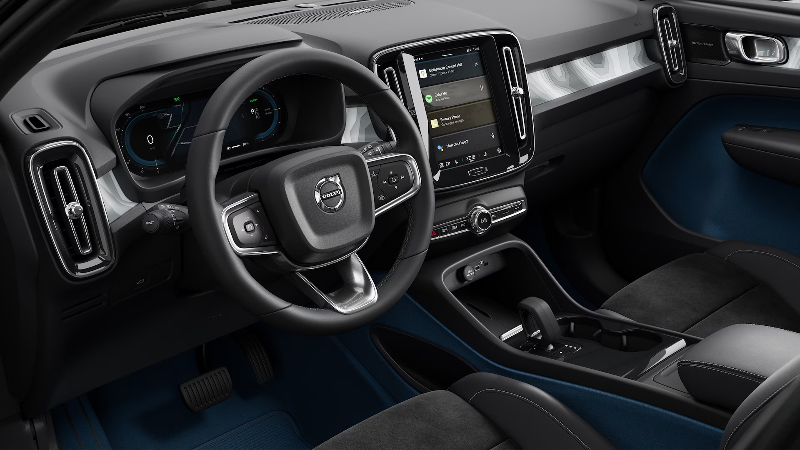
While many have stated their preference for more distinct colours, we find ourselves in favour of the existing palette, though the environment that we were in may very well have been the cause of this preference. The muted hues, especially fjord blue and sage green, were what enabled the vehicles to appear pleasantly at home against the Scandinavian scene. This was true whether the car was parked outside a coffee shop or under moss-covered branches by the lake, whether it cruised down the highway or passed dappled silver birch trees and charming Falu red cottages. It was as though the C40 had always been a natural part of the landscape.
It was clear that nature was a key design inspiration. If you look closely at the dashboard and front door panels, you will find a topographic trim, inspired by the majestic mountains in the Abisko National Park located in the heart of Swedish Lapland (more on this later), emitting a gentle back-lit glow when night falls. The look? Sublime. But more importantly, it is tasteful — a far cry from jazzy LED strips that border on gaudy.
High amounts of sustainable materials have also been utilised within the cabin. While the abstract panels are partly made of recycled plastic, the large swathes of carpet that extend to the sides of the tunnel console and front doors are made of 100% PET plastic bottles (71 per car to be exact). Moreover, the interior of this model is completely leather-free, a first for Volvo.
The environment also played a considerable role in the appreciation of the panoramic sunroof. While the natural light it ushered in offered the cabin a sense of airy openness in Gothenburg, the sunroof would fare differently when tested against Malaysia’s tropical climes. The lamination and tinting are supposed to protect occupants from glare and UV radiation, but the lack of a sliding cover may pose a concern for those with severe heat intolerance.
With that said, it was deep into winter, so the seat and steering wheel warmers deserve a special mention for keeping us toasty. But the excellent Swedish meatballs, served with mashed potatoes, silky brown gravy, pickled cucumbers and a generous heaping of stir-fried lingonberries, from Bruket i Wiared probably deserve an award.
dippedinbluec40testdrive_mattrobinson_-86.jpg
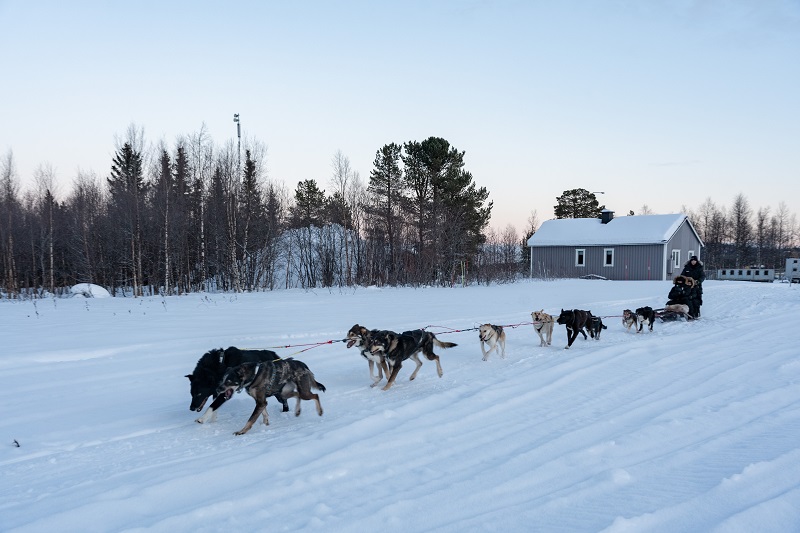
Above and beyond
It was a well-rounded trip that could have ended there, but Volvo being Volvo, the carmaker tended to push things a little further than what is expected.
We boarded a flight to Kiruna in Lapland — the place where its snow peaks inspired the interior panels of the car — and found ourselves in the Arctic Circle. Snow stretched as far as the eye could see, meeting a diffused horizon gently radiating with what few hours of daylight winter allowed. The exhilarated barks and howls of Alaskan huskies resounded faintly in the distance and grew louder as our cadre of journalists were led closer to the pack, revealing sleds that would bring us to our hotel.
The huskies, vocal with excitement, were eager to start running. After settling into the fur-covered seats in twos and threes, the dogs took off almost immediately. We swerved through woodland paths and frozen lakes, with the sun and moon hanging on opposite sides of the vast sky. We passed country houses blanketed with a duvet of thick snow and a large Christmas tree, still adorned with string lights, hinted at a way of life almost devoid of hurry. It was a joyride for the books.
We were told that the population of the city of Kiruna was below 25,000, so there is a higher likelihood of coming across an errant reindeer (whose numbers go well over 200,000) than another human being on the outskirts. It was also interesting to know that the municipality is home to one of the largest and most advanced underground iron ore mines in the world. But most of the tourists who make the journey are chiefly here for the famous Icehotel, the expansive wilderness, snow sports and, of course, experiences exclusive to the Arctic, such as the Northern Lights.
dippedinbluec40testdrive_mattrobinson_-150.jpg
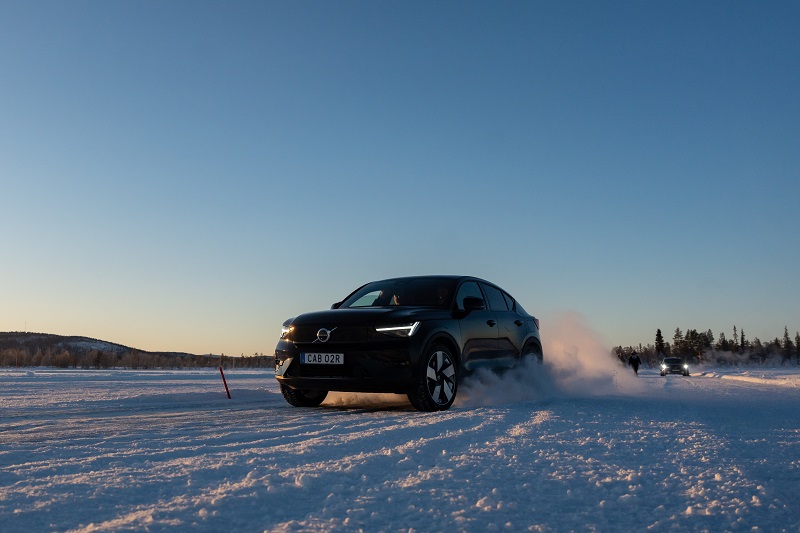
Volvo’s main intention for bringing us to Kiruna was a very special driving experience on ice. Slalom tracks were carved on the frozen Sautusjärvi lake and a fleet of nine fully electric XC40 and C40 models were lined up neatly at its edge. There were two slalom set-ups, one with tighter turns and the other with wider ones, marked by poles. A snow embankment was formed around the track, which warned against straying outside the path lest we literally tread on thin ice.
Volvo’s immutable raison d’être is safety, period. So, it was no surprise that both models’ Electronic Stability Control could not be deactivated, though switching to ESC Sport Mode was possible. The latter allowed for a more active driving experience as intervention from the system was reduced. This transfers greater control to the driver but the car could skid more.
Driving on ice was a whole new ball game, one that required good control and recovery. There were a few tips and tricks we learnt along the way that can be summed up and abbreviated to what we like to call the “4S”.
The first is speed. It is extremely important to drive slowly as the faster you go, the longer it takes for you to come to a halt. We averaged about 40kph to 50kph. The second is space. Leave room for reaction — touch wood — if unexpected slips occur, especially when there are vehicles in front of you. Next is steering. In the event that you lose control when turning, steer in the opposite direction (also known as countersteering). It helps to keep your eyes focused on where you want to go. This is also where Volvo’s active safety measures are put to the test. Once the car senses excessive skidding or a risk of collision, the seat belt tensioners tighten against the body (almost painfully) to secure the front passengers. It relaxes when the car regains control. And lastly, smooth movements will help in handling. One should also try not to cross their arms when steering.
It was an enjoyable experience weaving in between the poles, picking up a little more speed each time. We admit we might have been a little competitive in trying to churn out more snow than the other drivers, but to our dismay, the absence of a rear wiper meant that manual labour was involved in sweeping the fluff off the glass.
However, it would take more than that to spoil our fun. Powered by a 600W digital amplifier with 13 hi-fi speakers plus an air-ventilated subwoofer, the Harman Kardon sound system delivered a powerful and immersive audio experience. F R David’s Words came on the radio and we spun the volume knob all the way — an incredibly satisfying feeling that, by the way, cannot be replicated with screens. Rolling down the windows meant that the song reverberated throughout the track and let us just say we were not the only ones bobbing our heads to “words don’t come easy”.
20230201_222826.jpg
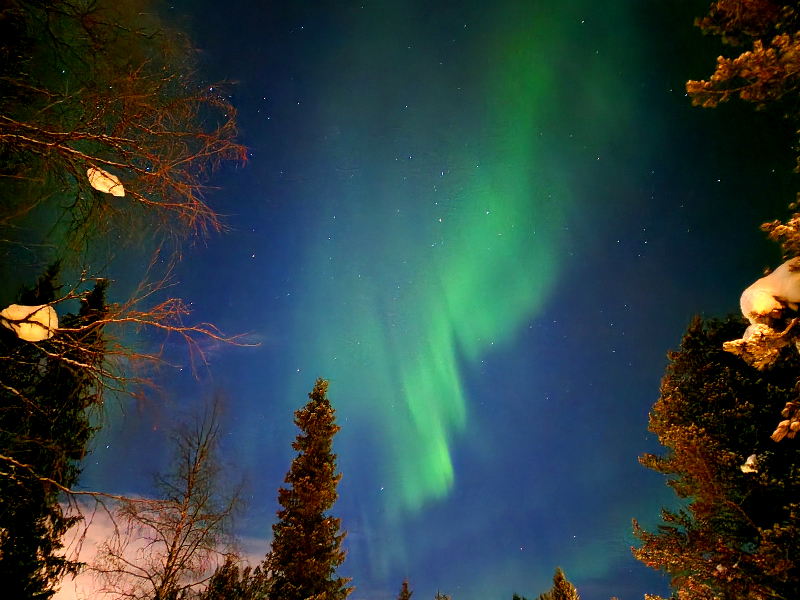
Our nights were no less exhilarating. If there was any event that possessed the draw to lure this writer out into negative-degree weather, it would have needed to be special. The extraordinary phenomenon of the Aurora Borealis dancing above our heads certainly exceeded that. Gleaming waves of green in undulating ripples stretched across the cloudless night sky, accompanied by the sparkle of a billion brilliant stars and a full moon rimmed by a rainbow halo.
There, by the towering pine trees and biting-cold wind, we were lost for words and enchanted. The only thought that ran through our minds was that this was at stake. Nature will pay for our price.
In a time when serious environmental changes are critical to ensuring our future, we are comforted that, at least in the world of automobiles, there is active progression.
This article first appeared on Mar 20, 2023 in The Edge Malaysia.


